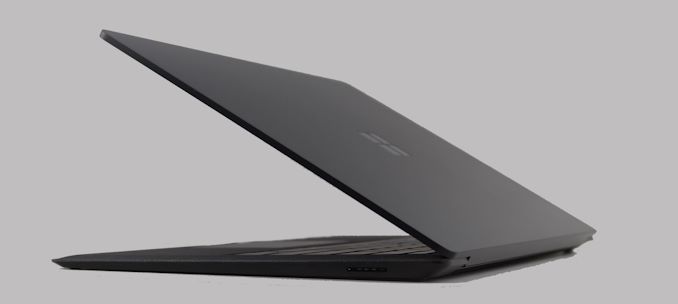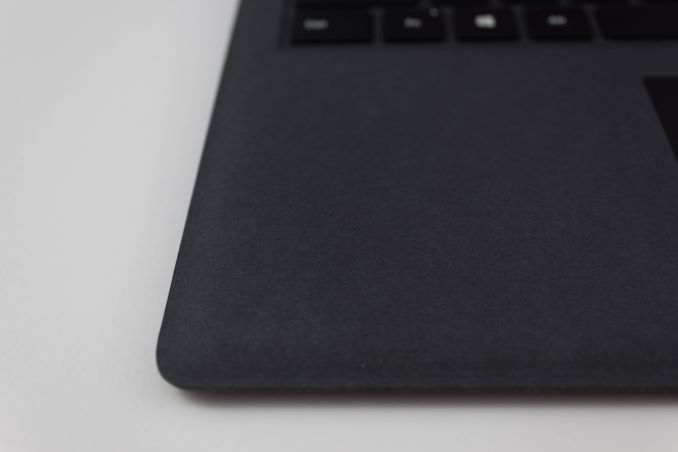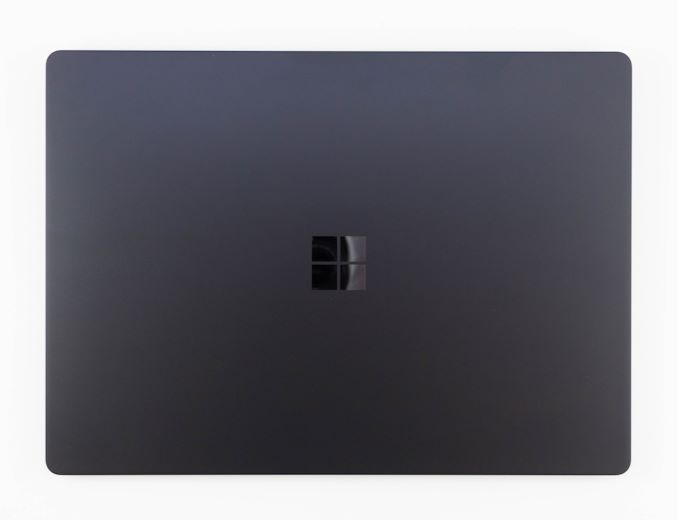The Microsoft Surface Laptop 2 Review: Surface Essentials
by Brett Howse on March 28, 2019 8:00 AM EST- Posted in
- Laptops
- Microsoft
- Surface
- Surface Laptop
- KBL-R
- Surface Laptop 2
Final Words
Prior to the launch of the Surface Laptop in 2017, every Surface device had a trick up its sleeve. Whether that was the kickstand and removable keyboard of the Pro, the detachable display of the Book, or the amazing display and hinge of the Surface Studio. Surface Laptop offers no tricks. It just wants to be a laptop. Does it succeed? Yes, mostly.
The design of the Surface Laptop 2 is fantastic. Microsoft has achieved the thin-bezel look, while still keeping the webcam and Windows Hello IR camera properly located in the upper bezel. The laptop is thin and light, and very easy to carry around. Although it shares the same display size as the Surface Book 13.5, it’s significantly lighter, making it easier to take on the go. The 3:2 aspect display also provides the laptop with great proportions, and a display that fills the entire space, rather than a large chin on the bottom.
Microsoft makes some of the best laptop keyboards around, and the Surface Laptop 2 is no exception. The keys have a great feel, and the Alcantara keyboard deck provides a really comfortable surface to rest your wrists on. Added to this is the excellent trackpad, which is right-sized and very responsive.
The performance jump from the original Surface Laptop is significant, thanks to the quad-core Kaby Lake Refresh based processor options, and buyers can choose a Core i5 or Core i7 to suit their needs. Microsoft has also dumped the 4 GB RAM option for this generation, which is a welcome change. There’s plenty of storage options available to fit different budgets too, from 128 GB to 1 TB, but make sure you buy enough upfront, since the BGA SSDs are soldered on.
The battery life is likewise excellent, with Microsoft managing to squeeze an incredible amount of runtime out of a relatively small battery.
The new matte black color scheme available with this generation is also a stunner, and looks even better than the matte black did on the Surface Pro 6. The glossy black Microsoft logo on the top adds a touch of character and contrast, and really rounds out the look.
The real controversy with the original Surface Laptop is unfortunately not fixed though. Offering just a single USB port is a strange decision, since it is not very user friendly. It would have been very refreshing to see Microsoft replace the Mini DisplayPort connector with a USB Type-C like they did on the Surface Book 2; but for reasons that are only known to the design team, they’ve chosen to keep this sore spot around with this generation. Microsoft has been slow to adopt this port, which is definitely a mark against this laptop, and precludes being able to charge it with the same charger as a phone, which would be a real benefit while travelling.
The display is also not quite as nice as the other Surface devices in its price category. Both the Surface Pro and Surface Book offer a higher pixel density, along with an Enhanced color option that the Surface Laptop 2 lacks. Considering all of these devices are similar in price at the low end, it would have been nice to see the Surface Book’s excellent 13.5-inch panel used here rather than a unique one for the Surface Laptop 2. It still offers a better display than most notebooks, just not quite as good as other Surface devices.
Overall, the Surface Laptop 2 is an easy laptop to fall for. It offers great styling, a good display, and the Surface touches such as a touch display, great keyboard, and great design. Some people won’t be able to live with a single USB port though, and that decision will knock this laptop out of consideration for those users. But if you don’t need a lot of connectivity, the Surface Laptop 2 is a fantastic device and worthy of consideration. The pricing is generally $100 more than the equivilent Surface Pro though, and that price gap expands significantly at the top end of the range to $400 more for the Surface Laptop for a 1TB Core i7 with 16 GB of RAM. That's a steep price hike over the Surface Pro 6, and is possibly why Microsoft sells far more Surface Pros than anything else in their lineup.













59 Comments
View All Comments
sorten - Thursday, March 28, 2019 - link
If I absolutely needed a laptop today I'd probably pick up a used one so I could wait for the Ice Lake CPUs from Intel this fall. It would be a shame to buy such nice hardware only to find yourself two significant generations behind within 6 months.yankeeDDL - Thursday, March 28, 2019 - link
I hope you're right. Intel has been caught sleeping, and the improvements since SkyLake have been, frankly, anecdotal. It seems that AMD, by making a small core, designed from the ground up to work in tandem with other cores, has a much more effective/scalable architecture. So a 4-core, 8-thread CPU from AMD, while providing slightly lower IPC, today, is much more effective than a 4-core, 8-thread CPU from Intel.Let's see if ICL brings real benefits. The 10nm node should help a lot.
smilingcrow - Thursday, March 28, 2019 - link
"So a 4-core, 8-thread CPU from AMD, while providing slightly lower IPC, today, is much more effective than a 4-core, 8-thread CPU from Intel."I thought AMD currently has lower IPC + lower clock speeds so how exactly are they more effective?
With Ryzen3/Zen 2 due in the summer this may change but for now AMDs advantage is more cores per buck.
niva - Thursday, March 28, 2019 - link
I'm assuming he meant in terms of price/core, but that's just a guess.Doesn't AMD have a big problem with power consumption in mobile CPUs though? I've read that the AMD laptops out now suffer from big power drain even if performance wise they're equivalent or batter than the Intel chips at the same price range.
Irata - Friday, March 29, 2019 - link
Supposedly in idle only, but I do not really see that on my Matebook. Then again, I do not let it sit idling for hours on battery since it boots so quickly that there is no reason for that.In normal use (web / video), the battery indicator does not move much at all.
What many forget is that even with Intel based laptops, there are sometimes big differences between models or manufacturer, depending on the battery size and how well they configured their laptop. The ones that aren't well done are not the ones you usually see in comparison tests though (as there are more models to pick from vs. AMD based ones).
lightningz71 - Monday, April 1, 2019 - link
Their big problem was definitely low power states management on the 2X00u series of chips. The 3x00 series chips that are now hitting the market make up a lot of ground in that regard, both with the chips themselves and better bios/uefi implementations by the vendors that are building the systems. Add in the fact that AMD has finally decided to take the lead on providing a stable, performant drivers for the video section of the chips, and you can largely ignore the abysmal efforts of the vendors themselves to provide quality, updated drivers themselves.For the money, some of the low end AMD 2x00u series laptops gave you MUCH more bang for your buck than the equivalent intel based offerings. The few limitations that people who purchased them did come across could be overcome through software tools by those that it actually mattered to (power and performance management profiles could be tweaked by certain software tools that allowed systems to maintain higher boost states longer and better manage their thermals).
I can't wait to see some of the more thorough write-ups on the latest 3x00h series laptops that are fast enough in both core performance and graphics performance to go up against comparable intel based machines that also include an Nvidia MX1xx series dGPU with an i5. They should technically be less expensive, offer similar performance and be more power friendly when pushed to their limits. This isn't to say that they won't have their flaws, just that, dollar for dollar, on the low end, you'll get more with the AMD system.
Manch - Friday, March 29, 2019 - link
Superior SMTsmilingcrow - Friday, March 29, 2019 - link
IPC includes the whole chip performance so they are still behind.Zen currently makes sense to me if you want 8 or more cores so hopefully with Zen 2 they will compete from 4 cores upwards.
Manch - Monday, April 1, 2019 - link
IPC refers to the perf of a single core usually. Generally has an advantage of about 8-10%. That advantage disapears when using SMT/HT. AMD has the more efficient design so it makes up for that 10% deficit. Throw in multiple core and it starts to win. TBS even now a lot of software is optimized still for Intel but thats changing rapidly. Intel still has a clockspeed advantage. Where as Zen has a pretty hard wall @4.3, Intel can get on down the road a good bit faster. Especially with 4 core chips. I dont think that advantage will last too much longer. Between the mitigations from ME/SPec, and lack of new architecture, Intel seem to be pushing cores over HT now to keep its advantage short term. AMD put out a competitive chip, Intel has yet to fire back like it did with Core against Athlon XPs(Those were the days!) Theyre just stretching their long in the tooth Core. Something is waiting in the wings though.smilingcrow - Monday, April 1, 2019 - link
From what I've seen a 6C/12T Intel beats a similar spec AMD easily.I've read that AMD's HT gives a bigger boost than Intel's but that still isn't enough for it to catch up due to it being too far behind in other areas.
So it's about as meaningful in the real world as a purely synthetic benchmark.
That should change soon with Zen 2 so there will be no need to live the life of a fantasist then.